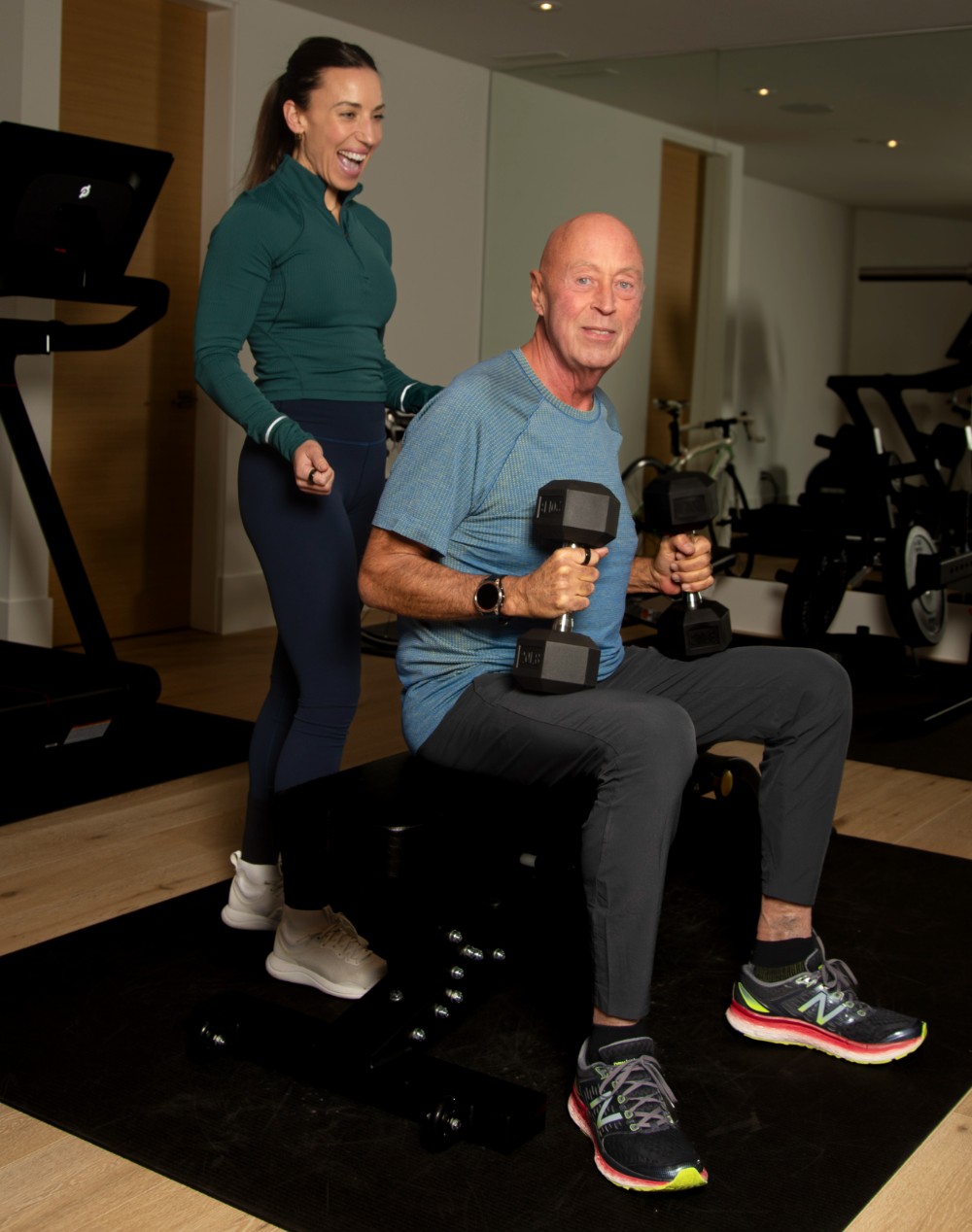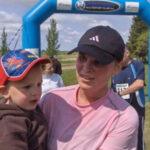As Olivia Chadwick and Garnet Morris ran together, their shared movement broke down barriers and created space for the duo to have deep conversations about their pasts, their hopes for the future and barriers that stood in the way of them reaching their potential. Now the pair have self published a book about their journey — “17 Runs: The Unbeaten Path to Unlock Life’s True Potential” — which explores lessons learned on the run.
Below is an excerpt from the first chapter, told from Chadwick’s perspective, in which Chadwick (an exercise physiologist and coach) and Morris (her client and later her chosen family) discuss how to recognize and remove bricks — life obstacles that form because of the people in your lives and the way you were raised.
***
We set out down a running trail we both liked, which meandered along the edge of the water. It was quiet and serene, and at this time of the morning, it felt like we were the only people in the world. My goal for that day’s session was to get him to run about a quarter-mile further than he’d gone so far, and when we were done, we’d head to the gym in his building for weight training and more stretching.
As we made our way towards the trail, we chatted about what was going on in our lives. This was a routine we’d quickly fallen into; like me, Garnet preferred to skip small talk and get to know people on a deeper level sooner rather than later. He’d been very open with me about his health journey so far. He’d lost over 100 pounds over the past several years, mainly through changing his eating habits. He shared a bit about some of the challenges he was having with his soon-to-be ex-wife, and even some anecdotes about his childhood, which, from what I could gather, had been very difficult.
Likewise, he knew about my goals with my personal training business and my estrangement from several members of my family. I was also fairly open about some health problems my son was having, which my partner and I were still in the process of understanding.

Since Garnet tended to run on the slower side, I paced myself to meet him where his body naturally wanted to be. We passed sleepy buildings along the edge of the frozen water, our breath visible in the frigid air. As we jogged, I told Garnet about the day I had ahead, which resembled most of my days as of late.
“After this, I’ll try to get home in time to help get Keenan to daycare, then I’ve got back-to-back training sessions till 5:30,” I said. “I’ll go home for dinner, then over to the Pilates studio to teach for a couple more hours.”
I related that I did all of this to keep a roof over our head and food on the table, but it was also very important to me to always be working towards a bigger goal: taking my business to the next level, working on myself, deepening or improving my relationship. My partner and I had a bumpy start; after dating on and off for years, we wound up pregnant shortly after I graduated from college. It changed both of our life plans completely. Still, I never gave up on my dream to advance in my career and make a better life for my son than the life I had had. In this way, my partner and I were different; he’s a hard worker and a deeply kind person, but like a lot of people in their twenties, he hadn’t found his passion and struggled with the demands of adult life.
That meant I was the primary breadwinner and he spent more time caring for our child. But after I worked for a few years, we had enough money for a down payment on a house. It wasn’t the biggest or newest, but it was ours: a charming, 1,000- square foot bungalow in a quiet, residential neighborhood. I thought eventually we would move on to something more. I had dreams of scaling my business and reaching more people with a message of empowerment, and in my heart, I believed I could do it. I just wasn’t sure where to start.
And this all came tumbling out while Garnet and I ran. It was unusual; typically I was the person listening during training sessions. My clients often treated me like a trainer and therapist rolled into one, which I didn’t mind at all. I enjoyed getting to know them as human beings. But I was rarely on the talking end. It was different with Garnet in part because he asked questions and then actually listened to the answers, and because we shared so many core values.
Either way, as I blathered on, I insisted I was doing everything I could to make our lives work and to set a good example for my child. On some level, though, I suspected I was being held back by fear.
“You know, Olivia,” Garnet said between puffs of white breath, “most people don’t realize they can overcome their family’s belief system. Meaning, you can make changes in your life to live the way you want, rather than just following the path you were raised to.”
We rounded a snowy corner, and the black sky before us began to turn a deep blue.
“That’s what you did, and it’s what I did,” Garnet continued. “We both came from difficult childhoods and made choices along the way to set us in new directions. It’s called ‘brick removal’: the determination to overcome the obstacles that are in your path, put there by your parents, their parents, the system in which you were raised, friends, social media, and so forth, one by one. Once you recognize the obstacles, it’s a question of being prepared for the discomfort you’ll feel as you move beyond your past patterns.”
I’d never heard my life framed that way before, and it brought me up so short that I almost stopped in my tracks. I grew up in a working-class family in England and was the $rst person to go to college. My trajectory didn’t strike me as unusual; it had felt very natural, even though it deviated from the example my family set for me. What happened then was that once my personal training business plateaued, I didn’t know what to do next—and didn’t trust myself to figure it out.
I’d inherited this brick, the feeling that I didn’t deserve to be successful. It was a belief that limited my idea of myself and my capabilities, and it was holding me back from growing and reaching my full potential. It was self-sabotage, and it meant that I didn’t even know how to take the first steps that would allow me to learn how to pursue my dreams or have my needs met. In fact, this message of not being worthy of more than what I was raised with was so strong in my mind and produced such powerful and loud negative thoughts that it was hard to even hear my own voice and desires.
After we’d run about two miles, Garnet and I paused to drink some water and catch our breath. It was almost time for us to turn around, so I gradually started to break into a run again before we lost momentum.
I turned his ideas over in my mind. “It’s almost like you have to become a different person, isn’t it?” I said. “Challenging those old belief systems means we can create a new reality.”
“Yes,” he replied. “We’ll always play those records in our heads, the ones that were put there when we were kids, but you have to create your own perspective, which will likely be in con”ict, to a large degree, with your family values and how they were brought up and lived their life.”
I thought about how scared I’d been to move away from home, even though I’d known it was the right thing to do. That was when I began de#ning my values for myself. It was the removal of my first brick. Now, it was as if I was still carrying around the others and putting them in my own way because that’s how I felt comfortable.
“Most people don’t understand what it means to move beyond what they’ve seen and imagine something different,” Garnet continued. “Your innate ability to do so means you’re on the right track.” As he said it, the sun was starting to peek over the horizon, hitting the exterior of Garnet’s building in a way that turned its blue glass walls into an iridescent rose-pink.
When I got back to my house that day, Keenan was already awake. He was joyful and delighted to see me, and I gave him a big hug. My partner was awake too, and the two of them were playing with stuffed animals on the rug in the living room. With Garnet’s words still echoing in my head, I could feel myself beginning to soften.
I thought about what a brick really is. It’s hard, yes, and it’s heavy, and it has the potential to weigh someone down. But it’s not impenetrable. If I wanted to remove a brick, I simply needed to understand what it was made of, believe in my power to remove it, develop the skills to do so, and be willing to keep trying—maybe multiple times if I didn’t get rid of it on my first attempt. I needed to create an internal voice that questioned why I kept it around in the first place.
These were all steps I knew I could take. Old beliefs can create a reality, but they don’t create the only reality.
When my morning session started with Garnet that day, I felt unsure about my efforts and the direction in which I was heading. But now that I had this new language for what I was dealing with, I could feel something beginning to shift. Maybe I’m already doing a lot of the right things, and I just need to be a little bit gentler with myself, I thought. I didn’t know where all this was going, but I did know I’d already begun the work and that at the end of the day, it was up to me.









